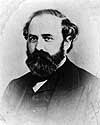After the Revolution, animpoverishedVirginia continued to rely heavily on the production and sale of tobacco. This practice led to soil depletion and as a result Virginia's tobacco production dropped and the state suffered economically. The war also eliminated most of Virginia's trading fleet as well as the navy. In spite of that, the region's shipbuilding capacity was at its best. The plentiful supply of shipyards, abundant supplies of timber for building ships, and skilled craftsmen put a trading fleet back in operation and formed the core of the American Merchant Marine.
By 1800, when Britain was already a leading industrial nation, the United States still had an agricultural society. Most manufactured goods were imported from England or made in small craftsmen's shops or at home. The majority of trade between cities was done by sailing vessels. The situation of Virginia and Maryland on the Chesapeake Bay made them hubs of trade activity. During this period in America, roads were nothing more than dirt paths, impassable for wagon travel during the rain and snow.Many Virginians migrated to the west, northwest, and southwest, seeking unspoiled land. To help end the economic downturn, efforts began in 1803 to improve the agricultural methods used by farmers in the long-settled parts of the South. From 1818 to 1833, agriculturist Edmund Ruffin (1794-1865), Virginia born and educated, wrote articles encouraging changes in farming. As manager of his family's plantation, he had found that poor farming methods, dependence on one crop (tobacco or cotton), poor field drainage, and haphazard plowing had depleted the fertility of the soil. He also found that applications of marl (loose crumbly soil containing calcium carbonate to fertilize soilsdeficientin lime) on farmland resulted in improved crops. His book,An Essay on Calcareous Manures(1832), and his lectures on scientific farming changed agricultural practices in Virginia and the rest of the United States. 奴隶制仍然是弗吉尼亚州南安普敦县的五十七名白人,妇女和儿童死亡的事件,仍然是体力劳动劳动力的主要来源。奴隶制的“特殊机构”继续成为增长的推动力经济基础of the Chesapeake Bay region. Virginia's economic future continued to improve when the state began a system of chartered banks in 1804 and started building roads, canals, and railroads. A state university and several colleges were founded before 1850; public schools had been established, and private schools flourished. Virginians began direct trade with Europe and South America. By 1860 Virginia was the leading manufacturer in the South. Tredegar Iron Works, in Richmond, was one of only two iron foundries in the South at the time of the Civil War, and provided all the iron used to construct theCSS Virginiaout of the remains of the Union shipMerrimac. This construction took place in Portsmouth, Virginia at the Gosport Naval Yard, home to the largest shipyard in the South.
 |
| A View of Baltimore Harbor from Federal Hill. Ship traffic includes sail and steam vessels. |
In addition to agriculture, the growth of the railroad contributed to the economic development of both Virginia and Maryland. During the early and mid 1800s, Baltimore became an important industrial city. A leading seaport and shipbuilding center, it also was the hub of transportation for goods being shipped west from Baltimore to Ohio on the Baltimore and Ohio Railroad (B&O). In 1830 Peter Cooper built the first coal-burning steam locomotive. Called theTom Thumb,火车跑的赌注ween Baltimore and Ellicott City. In 1836 the Louisa Railroad in central Virginia was established. It became the Virginia Central in 1850, expanding westward to the Allegheny Mountains in 1856. Important to the Confederacy during the Civil War, it expanded its routes westward to the Ohio River after the war. Many of the South's rail lines were destroyed during the Civil War as the Confederacy tore up the tracks to melt down the iron rails for cannon and ammunition. This left the South desperately lacking in railroad infrastructure when the war ended and the state began the job of putting the region's economy back together again.
 |
| Inclis P. Huntington,1821-1900 |
In 1868 the Virginia Central received funding from Collis P. Huntington, builder of the Central Pacific portion of the Transcontinental Railroad. As the routes were extended into other regions, the railroad was renamed the Chesapeake & Ohio to recognize its new wider mission. The railroad began transporting coal from West Virginia, Ohio, and Kentucky, to the terminus at Newport News, Virginia.
|

